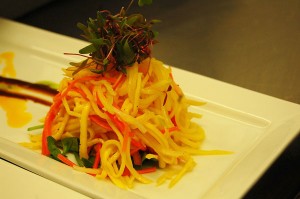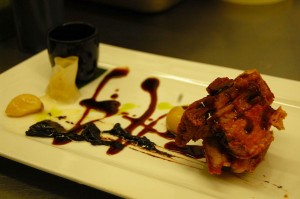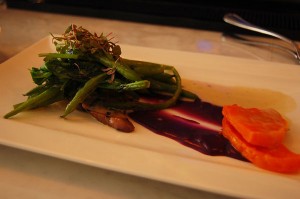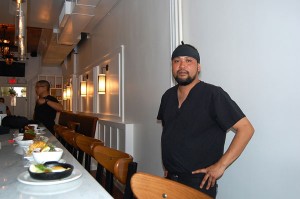LAMESA FILIPINO KITCHEN: Filipino Food for the Adventurous
LAMESA FILIPINO KITCHEN: Filipino Food for the Adventurous
By Beatrice S. Paez
In a whirlwind five months, chef Rudy Boquila and his business partner, Lester Sabilano, kick-started a dream that had been nesting in their minds for years.
Their “baby,” as Sabilano calls their restaurant, Lamesa Filipino Kitchen, is the latest addition to Toronto’s West Queen West, a two km. stretch of hipster boutiques and restaurants between Bathurst Street and Gladstone Avenue.
When Boquila and Sabilano met only five months ago, Boquila said, “It was just about putting the pieces together.” Together, they plan on debuting Filipino cuisine to the mainstream food culture of Toronto.
Traveling to most Filipino restaurants often involves a detour from the downtown core, but Lamesa treads its own way down to every course. Boquila serves modern and deconstructed versions of classic Filipino dishes like the adobo and uses some traditional flavours to produce creative new dishes.
His desserts include a Filipinized version of crème brûlèe — a delightful confection of such favourites as leche flan, halo-halo, and turon – all rolled together. Underneath its caramelized exterior is Boquila’s favourite halo-halo condiment, jackfruit. He uses Carnation milk, a staple in many households in the Philippines, as a binding ingredient. Not a fan of jackfruit but with a soft spot for crème brûlée, I was curious which taste would win over. It was a perfect blend of ingredients.
Alternatively, you can also give his coffee and pan de sal bread pudding a chance. Playing on memories of mothers and grandmothers dipping their pan de sal into their coffee over breakfast, his bread pudding topped with Carnation ice cream makes this experience more palatable for younger generations and unconditioned taste buds alike.
“Filipino food, I would say is more for the adventurous. The flavours are very friendly, it’s just the presentation of it, the kinds of meat that they use…we have to make them more palatable,” said Boquila. Filipino cuisine draws influence from the Chinese, Spanish, American, among others.
Creative flair
With his head wrapped in a black headband and a fish tattoo blazed onto his arm, Boquila looks about ready to karate chop some fish for sushi. Instead the Japanese aesthetic seeps into his plate designs with his strokes of caramelized bagoong, purple yam and pineapple reduction drizzled onto his dishes.
Like a child eager to show off his latest sketch, Boquila emerges with his current favourite, crispy pork belly adobo and says to the friends and family gathered, “It looks just like a painting!”
Bathed in an amber glow, Lamesa strives to achieve a modern Spanish colonial face, a “Makati meets Intramuros” look as Christine Bagol, Sabilano’s wife puts it. There is a tiny Santo Niño figure, set alongside colourful jars of banana ketchup, picked daikon and sayote, that watches over the restaurant.
My tasting menu leads off with the “Lola,” a mixture of lychee, almonds, orange, calamansi and brandy that is supposed to be a fruit salad cocktail. Calling it a fruit salad – another ubiquitous Filipino dessert – is a stretch, however. This blend just tastes like a hyped up version of calamansi juice with alcohol.
Broken into three sections of choice, “Pulutan,” “Ulam,” and “Dessert,” the menu while heavy on the meat is also vegetarian friendly. Leading the pack for the pulutan, is his chicken sisig. Seasoned with garlic, chilies, onions and pico de gallo and dressed with an egg. It was savoury and thankfully, not bathed in oil, as most Filipino food tends to be.
The vegetarian pancit was disappointing; it was bland, lacking a kick of flavours that I normally associate with one of my favourite dishes.
More remarkable were the beef short rib kaldereta and the crispy pork adobo, which both left me craving for more. Tender, with different layers of flavour, the beef kaldereta is garnished with roasted red peppers, olive tapernade, and fingerling potatoes. With the classic ingredients used in adobo at play, Boquila takes this humble dish to new heights.
Accidental chef
Boquila and Sabilano shift and avert their gaze from the camera as I set out to photograph them. A first-generation Filipino-Canadian, Boquila carries himself with a blend of confidence and humility. Having gone to school for advertising at Seneca College to pursue a career in radio, his foray into the restaurant industry was accidental: first, it kept his rent checks flowing and later, evolved into a wholehearted passion.
With 17 years of experience in the culinary industry under his belt, he’s worked the circuit from stints at the now defunct BamBoo Club, where he got his first break, to concert catering on a tour with U2.
Though he doesn’t discount the benefits of a formal culinary education, he says there’s more to thriving in the kitchen than what’s taught in a classroom. He’s also taken two young sous-chefs under his wing. “I encourage my chefs to draw stories from their past and put it in their food,” said Boquila.
With Boquila at the helm of the kitchen, Sabilano takes the lead in balancing the books. Opening restaurants is familiar business for Sabilano. His family launched the Toronto Filipino restaurants Kaibigan and Barrio Fiesta. While his familial connections helped get the restaurant off the ground, Sabilano is also an entrepreneur himself, co-creating the clothing line, TheONE.
Sabilano and Boquila’s paths collided when a mutual friend at Kapisanan Philippine Centre, a youth-led community organization introduced them. As Bagol said, “It was kismet.”









Comments (0)